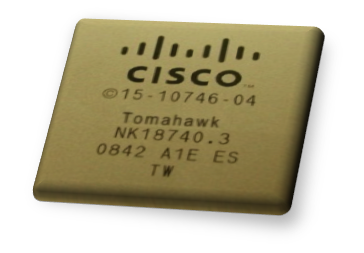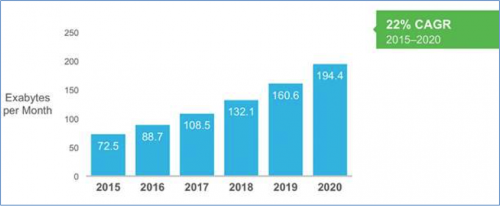
The answer is the ASR9000 Tomahawk line card
Where is the growth in network traffic coming from and how to manage it?
Everyone knows about the Visual Network Index (VNI) that Cisco keeps up to date about the current status and 5 year forecast of internet growth factors. These include overall bandwidth, number of clients, types of application traffic streams, and number of devices. Just in case you don’t then here it is, and so far it has proven remarkably accurate.
The overall expected Exabytes of IP traffic per month is shown here and an Exabyte is a billion billion in case you wanted to ask.
Cisco VNI Forecasts 194 EB per Month of IP Traffic by 2020
Source: Cisco VNI Global IP Traffic Forecast, 2015–2020
The slightly worrying thing is that the growth shows no signs of slowing and in fact will increase at an even higher rate than before. Now why is this happening, I hear you ask? Well one factor is that we all have smarter devices with better quality screens and nicer apps, and this means that we can now do video calls, and watch high quality videos over the internet on our mobile devices and on smart TVs. This would have been unthinkable a few years ago but this has been made possible by advances in technology for displays and the power of silicon, higher bandwidth availability, and easier ways to use video.
The SP design challenge
In a Service Provider network there are many scaling factors which will be challenged by the VNI growth figures.
- Data rate – the bandwidth is growing so more capacity per device is needed in the network
- Devices – this means more traffic flows, queues, and devices to be tracked and authenticated
- Services – the number of services being consumed by SP customers increases which means more effort in testing new services, changing the network to provide them, and monitoring to make sure they are being delivered properly.
- Competition – the large cloud based competitors like Google and Facebook are offering over-the-top services using the internet with very rapid delivery of new services.
It is important to connect the customer’s network connections to equipment that can be expanded as this high rate of growth is taking place. Ideally this must be done without having to undergo the disruption of changing out the equipment and this is where the Cisco ASR9000 network equipment needs to add new function.
Cisco ASR9000 new capabilities
The ASR9000 is widely used in SP networks as the mpls core and edge. It has been proven to be reliable and flexible for all types of services and is very successfully used in Mobile, SP and Video networks
To meet the challenges mentioned earlier the ASR9000 needs to be able to expand and rapidly add new services and scale, this is where the new Tomahawk line cards are aimed.
Tomahawk Line Cards
These line cards increase the per slot capacity from 360 gigabits per second (gbps) per slot to 800 gbps, along with 1.2 terabit per second (tbps) line cards being planned. They use the Cisco developed Tomahawk ASIC (application specific integrated circuit) which provides unique support for:
- 240Gbps in each chip
- very low power draw per port
- the option to power down ports when unused
- configure each port as 10G,40G or 100G
- MACsec for built in security with authentication and encryption between ethernet devices.
Using this ASIC these Tomahawk line cards provide 100 Gbps Ethernet port density and flexible port options as well as being part of a new programmable capability.
Flexible port configuration can be used to provide 100G, 40G or 10G options from the same line card port so the SP can quickly add new services without changing the line card. Here is the 8 port 100GE line card as an example

Business benefits
Why are these line cards so important and why should I buy them, I hear you ask?
The answer is to achieve cost savings and to support more revenue generating services, and I will now explain why using the Tomahawk line cards will help you achieve this.
More Revenue
- New services – adding more video services is possible as the line cards have very high volume of advanced and scalable low latency queuing
- More speed – when high capacity is required for a service it is available without having to re provision the customer
- Programmability – support of open APIs and programming languages leads to fast provisioning of customer services and the option to easily offer shorter duration contracts for competitive advantage
- Flexibility – easy re-use of ports for new services without feature limitations
Cost savings
- Upgrade your ASR9000
- Existing line cards can remain in place and the new cards added for more capacity with minimum disruption. The route processors can also be upgraded to support the highest speeds
- Lower per port costs
- Cost per gigabit – these ports are about 60% less per gogabit than on the previous line cards
- Reconfigurable ports – the same port can be used for 10G, 40G or 100G so reducing costs to introduce new services
- Pay as you grow charging – Cisco will only charge for the ports that are being used when the others are powered down. Additional ports can be activated with a simple license so the power and space advantages of the tomahawk line card can be enjoyed without having to pay for all the ports.
- Power and space savings
- Reduce power costs – in a high capacity line card some of the ports may not be in use at first but will be needed for later growth. These new cards can have the power turned off on the unused ports which literally saves power
- Reduced electrical power used per gigabit
- Less space per gigabit – these higher capacity cards produce more throughput in the same size chassis
Operational advantages
- IOS-XR – this carrier class high availability software operates across all the ASR9000 models as well as on virtual routers and other Cisco core routers like the CRS and NCS6000. There are significant operations resource advantages of having the same software for provisioning, testing and management
- Automation benefits
- Rapid service introduction – IOS-XR can use open APIs which enable automation of service addition. This saves on deployment time as well as reducing the possibility of errors. This can greatly improve the time to market of new services and reduce the customer provisioning time with the obvious cost benefits to your business.
- End to end service provisioning – with APIs comes the opportunity to coordinate new services across the whole network and data centre bringing a whole new set of business benefits. Complete new services can be deployed in minutes rather than months and facilities can be rapidly reconfigured to meet new market needs. In addition analytics can be used across the solution to track the effectiveness of the new high speed services
In summary
In order to meet the ever growing capacity growth, rapidly deliver new services, and at the same time reduce costs, you should consider adding the flexibility and power of the Tomahawk line cards to your mpls network in the ASR9000.
For further information please see here
Tags:



